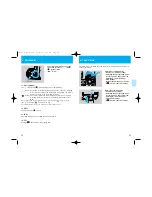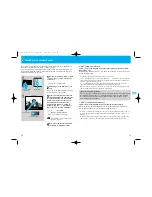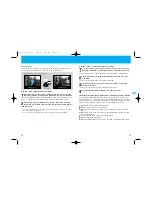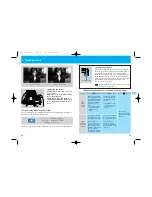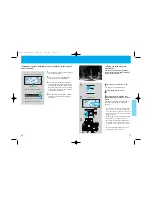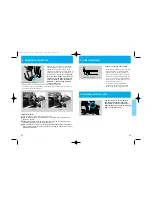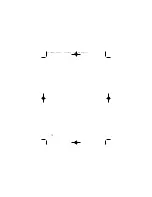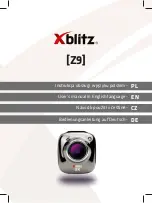
<Evaluative metering (
mark)>
With evaluative metering, the picture is divided into
five sections, as illustrated. The autoexposure sys-
tem calculates the appropriate exposure based on
an analysis of subject conditions and positioning.
Because of this,
evaluative metering can be
used not only for general photography but
also when the subject is lit from behind, with
virtually no exposure compensation or adjust-
ment required.
“
” The exposure meter in the viewfinder may
be changed to display evaluative metering
and center-weighted average metering, or
the difference between center divided par-
tial metering and the measured value.
<Center-weighted average metering)
(
mark)>
In this mode, the light is measured with emphasis
on the brightness of the subject at the center of
the viewfinder. To a certain extent it also takes into
consideration the brightness of the area surround-
ing the center to determine the exposure value.
This mode can be used for general photogra-
phy but also for easily determining the expo-
sure for subjects in motion.
<Center divided partial metering>
(
mark)
Only the brightness value of the subject corre-
sponding to an area of approximately 5% of the
scene is measured.
Use spot metering
when the difference between
the brightness value of the subject and the
background is high. A good example is people
lit from behind or standing in spotlights on
center stages.
It can also be used for making
very selective readings of specific areas within the
scene.
49
<Automatic metering range>
This table shows the mutual relationship between aperture, shutter speed and
EV (exposure value). For example, when using ISO 100 film and an 50mmF1.4
lens in the average metering mode, the automatic metering range is the range
indicated by the points where the line extending diagonally from “16” (the Planar
T *50 mm minimum aperture is F16) and “1.4” (the maximum aperture) on the
aperture table's ISO 100 section intersects with the vertical line (the EV line)
and horizontal line (the shutter speed line). Thus, that is EV “0” to EV “20”.
* The EV expresses the combinations of aperture and shutter speed that achieve the same
exposure effect on film. For example, the table shows that at EV 13 the same exposure
effect can be achieved at F16 at 1/30 and F8 at 1/125 second. While the EV represents
an equivalent exposure the image effects of faster and slower shutter speeds and larger
and smaller apertures differ.
48
6400
3200
1600
800
400
200
100
50
25
12
6
ISO
1.4
2
1.4
2.8
2
1.4
4
2.8
2
1.4
5.6
4
2.8
2
1.4
8
5.6
4
2.8
2
1.4
11
8
5.6
4
2.8
2
1.4
16
11
8
5.6
4
2.8
2
1.4
22
16
11
8
5.6
4
2.8
2
1.4
32
22
16
11
8
5.6
4
2.8
2
1.4
32
22
16
11
8
5.6
4
2.8
2
1.4
32
22
16
11
8
5.6
4
2.8
2
32
22
16
11
8
5.6
4
2.8
32
22
16
11
8
5.6
4
32
22
16
11
8
5.6
32
22
16
11
8
32
22
16
11
32
22
16
32
32
22
1/2000
1/1000
1/500
1/250
1/125
1/60
1/30
1/15
1/8
1/4
1/2
1
2
4
8
16
32
1/4000
21
20
19
18
17
16
15
14
13
12
11
10
9
8
7
6
5
4
3
2
1
0
1. Types of metering modes and their features
2. Metering range
Center divided partial metering
The autoexposure system in the camera
measures light in a shutter speed range
of 32 seconds to 1/4000 second in the
auto exposure mode.
The parts indicated in color within the
range indicate the automatic metering
range when using ISO 100 film and an
F1.4 lens.
Center-weighted average metering
Center divided partial metering range
Evaluative metering
Metering sensitivity chart
Metering sensitivity chart
Image
field bottom
Image field
top
Image
field bottom
Image
field top
Difference between center-weighted aver-
age metering and the measured value.
Metering sensitivity chart
Image field
bottom
Image field top
Exposure meter in viewfinder
shutter speed (second)
EV value
08-1BC(E)_P047-49 11/15/01 7:28 PM Page 48



